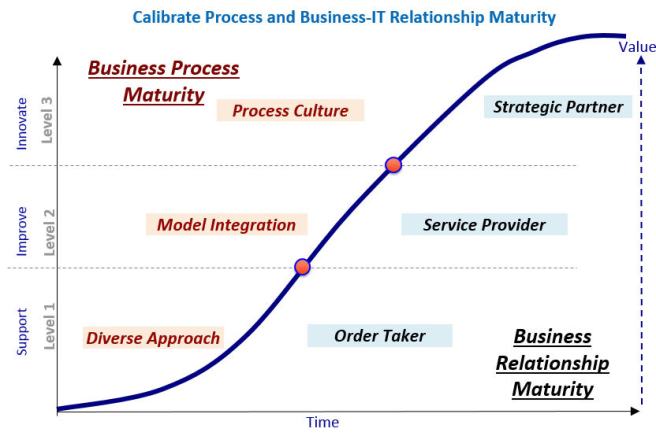Use of information technology. Is it creating value? Is it improving business processes and capabilities? Or merely creating new wants? Is it important, or only urgent? What is it for? Every Business and IT engagement around business requirements revolves around these questions but managing it isn’t always easy.
First, let’s talk about IT organization’s critical role in the company’s business processes. One of the consequences of Business Process Management is a large majority of these programs are initiated in the IT organization. There are very good motives for this. One of the most common: the IT organization is responsible for providing the technology that enables business processes. Take for example, ERP (Enterprise Resource Planning) systems like SAP, Oracle, etc. This ERP solution is a suite of integrated applications that a company can use for many business processes. Most ERP systems incorporate best practices reflecting the vendor’s interpretation of the most effective way to perform each business process. Systems vary on how conveniently the customer can modify these practices. Talking about best practices, it is advisable not to over-customize because doing so will keep you from taking advantage of the expected improvements and innovations from the purchased ERP package.
How do you characterize the nature of your engagement with your business partners? Is it functional orientated? If it is, there is more tendency for having more solution-based discussion versus process- and value-based. Even worse, it could be possible that your internal customer is engaging you at the tail end of their decision cycle–when they have already determined what they want or need. There is lack of business-IT alignment and strategic partnership.
How do you then improve the level of your business relationship with the business? There are numerous paths towards that elusive business-IT strategic partnership. In this post, I will talk about Business Process Maturity as a path— so I would say – Let’s Talk Process First! This has worked for me in the past. One of the most effective ways to change the orientation and focus of business IT interactions is to start with business process. Calibrate your organization’s business process maturity and you will take along with it to a great degree IT-business relationship maturity. What you need are experienced business process managers with business relationship management competencies. Below I will walk you through these 3 stages of Business Process and Business Relationship maturity and describe what it means.
Business Process and Business Relationship Maturity
Level 1: Support
Business Process Maturity = Diverse and Business Relationship Maturity= Adhoc / Order Taker
When your organizational approach to business process is diverse, more often business-IT initiatives are managed with lack of integration. At this stage, most of the organization’s process knowledge is known only to a few individuals. For business process engagement facilitation, there is dependency on external consultancy. There is no standard process management discipline that leads to more functional orientation of IT requirements discussion. Consequently, IT as a provider organization is hardly seen as a strategic partner–at most, a service provider. In terms of business relationship maturity level, most of the time, IT is treated as an order taker. This type of business relationship is characterized by loudest in – first out tendency causing reactive course of actions. My advice is to embark on a business process maturity journey. Establish a discipline of managing business processes as the means for improving business performance outcomes and operational agility. Leverage use of technology to improve business processes.
Level 2: Improve
Business Process Maturity = Model Integration and IT-Business Relationship Maturity = Service Provider
You want to become an organization that designs processes first and then goes on to implement the technology enablers. Your organization wants to keep pace with technology and maintain a competitive advantage. Companies at this level adapt a consolidated method to design and implement business models using standard processes and tools. Process ownership ultimately improves as management breaks silos and approaches process and technology implementation equally. The common tendency is for companies to establish process governance and ownership. IT plays a key role in the process evolution of the company and starts to be seen as a service provider and some cases even a strategic partner.
Level 3: Innovate
Business Process Maturity = Process Culture and IT-Business Relationship Maturity = Strategic Partner
The final step to Process Culture Maturity occurs when innovation and change in business practices through process understanding are consistently promoted within the company. As executives passionately embrace process thinking, they are able to promote innovation more confidently when implementing new technologies. In many cases, companies with mature process culture has End-to-End orientation to process management and IT plays a key role as center of process excellence. IT starts to be regarded as trusted and strategic partner. Business–IT relationship is based on cooperation and mutual trust with shared goals to maximize value from business initiatives.
Technology will not automatically implement itself and run your organization’s processes the way you envision. IT has a unique opportunity to spearhead business process improvements in the company. Start by changing the orientation of your business interactions from functional to business process, from solutions to value. Do not shy away from this opportunity. Use business process management to create greater strategic value and by doing so advance business-IT relationship level to new heights.
